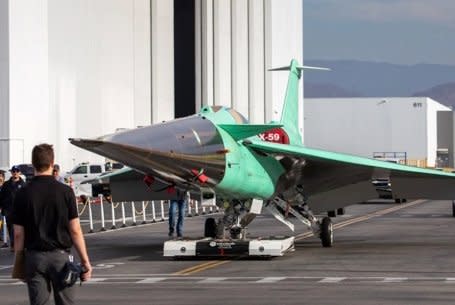NASA delays X-59's sonic boom test flight until 2024

Oct. 12 (UPI) -- NASA on Thursday said it is pushing back the first flight of its experimental X-59 supersonic aircraft to 2024.
Though the aircraft had been scheduled to take its first flight this year, NASA said engineering teams involved with the Quesst mission need more time "to fully integrate systems into the aircraft and ensure they work together as expected."
NASA also said the team is resolving intermittent issues with some of the safety-redundant computers on the plane.
Quesst is an experimental mission seeking to explore the possibilities of supersonic flight over populated land using the experimental Lockheed Martin X-59 QuessT (Quiet SuperSonic Technology) aircraft being developed at Skunk Works for NASA's Low-Boom Flight Demonstrator project.
The Quesst mission has several goals, NASA says, including reducing the loudness of sonic booms as they are heard on the ground. Plus, the aircraft is designed to fly over several U.S. population areas to gather data on public responses to the jet's sound generated during supersonic flight.
The info gathered from these test flights will be analyzed by U.S. and international regulators in an effort to determine if supersonic flight over land is possible without the typical sonic booms created by the shock wave of the aircraft flying faster than the speed of sound.
Though supersonic travel offers the ability to drastically reduce flying time, the loud sound of a supersonic aircraft's sonic boom can be dramatically disruptive to humans and even damaging to structures on the ground.
The X-59 is being designed to fly at supersonic speeds but without the typical loud sonic booms aircraft create when flying past the speed of sound. The aircraft -- being developed by prime contractor Lockheed Martin's Skunk Works -- combines new technology with existing systems and components from other jets such as the F-15 and F-16.
The 25,000-pound aircraft is designed to fly at speeds reaching at least Mach 1.4.
"Quesst made steady progress toward flight over the past year," NASA officials said. "The team installed the finishing touches to the X-59's tail structure, which allowed them to finalize its electrical wiring and proceed to critical ground tests, and moved it from its assembly facility to the flight line to perform structural testing."
According to information at Lockheed's website, the X-59 has the potential to reduce the sound of its sonic boom "by tailoring the volume and lift distribution" of the aircraft to separate the shock waves produced during supersonic flight.
The result, engineers say, is that the plane shouldn't produce a loud sonic boom, rather a "quiet sonic thump" instead.
